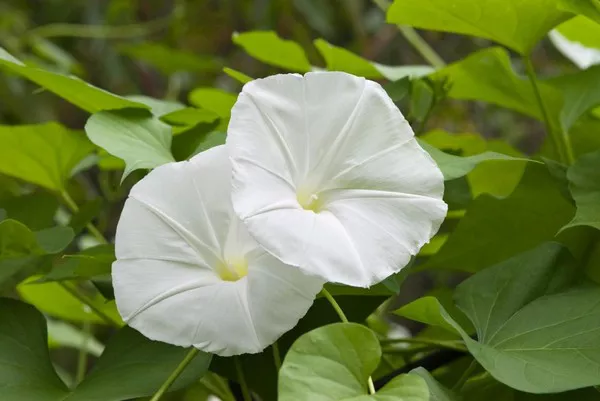Moonflowers, with their ethereal allure and mystifying charm, have captivated humanity for centuries. As nocturnal bloomers, these enchanting plants offer a unique spectacle, unfurling their delicate petals under the moonlit sky. In this comprehensive guide, we delve into the intricate anatomy, diverse variations, symbolic significance, and practical cultivation techniques of moonflowers, unraveling the secrets behind their timeless appeal.
Anatomy of Moonflowers
Moonflowers, scientifically known as Ipomoea alba, belong to the family Convolvulaceae, commonly referred to as the morning glory family. These vining plants are renowned for their large, trumpet-shaped flowers that bloom predominantly at night, emitting a sweet, intoxicating fragrance to attract nocturnal pollinators such as moths and bats.
The anatomy of a moonflower encompasses several distinctive features:
1. Flowers: The hallmark of moonflowers, their flowers typically measure 3 to 6 inches in diameter, boasting pure white petals that unfurl in a spiral pattern. The flowers often have a subtle blush at the base, adding to their celestial allure.
2. Leaves: Moonflower leaves are heart-shaped or lobed, exhibiting a deep green hue. These foliage provide an attractive backdrop to the luminous blooms, serving as a lush canvas for the moonlit spectacle.
3. Vines: Moonflowers are vigorous climbers, boasting twining stems that allow them to ascend trellises, arbors, and fences with ease. Their robust vines can reach impressive lengths, providing ample support for the profusion of flowers.
4. Roots: The root system of moonflowers is relatively shallow, preferring well-drained soil to thrive. While they can tolerate periods of drought, consistent moisture is essential for optimal growth and flowering.
Variations of Moonflowers
While Ipomoea alba is the most widely recognized species of moonflower, several cultivars and hybrids offer a spectrum of variations, each with its own unique characteristics:
1. ‘Bianca’: This cultivar features exceptionally large flowers, spanning up to 8 inches in diameter. ‘Bianca’ moonflowers exhibit a more pronounced fragrance and may bloom earlier in the evening compared to the standard species.
2. ‘Luna’ Series: The ‘Luna’ series comprises compact, bushy plants that are ideal for containers and small gardens. Available in shades of white, pink, and lavender, these hybrids offer a broader color palette while retaining the signature traits of moonflowers.
3. ‘Alba’: True to its name, the ‘Alba’ variety showcases pure white flowers with a luminous quality that enhances their nocturnal appeal. This classic cultivar remains a favorite among gardeners for its timeless elegance and ethereal beauty.
4. Double-flowered Cultivars: Some cultivars of moonflowers feature double or semi-double flowers, imbuing them with a more substantial and opulent appearance. These varieties often exhibit enhanced fragrance and are prized for their ornamental value.
Significance of Moonflowers
Beyond their aesthetic allure, moonflowers hold profound symbolic significance across cultures and traditions:
1. Mysticism and Spirituality: In many spiritual traditions, moonflowers are revered as symbols of enlightenment, transformation, and spiritual awakening. Their nocturnal blooming habits are often associated with the mysteries of the night and the cyclical nature of existence.
2. Romance and Romance: Moonflowers have long been associated with romance and love, evoking sentiments of passion, devotion, and enchantment. Their luminous blooms and intoxicating fragrance make them popular choices for moonlit gardens and romantic settings.
3. Femininity and Fertility: In some cultures, moonflowers are linked to femininity and fertility, embodying the nurturing and life-giving qualities of the moon goddess. They are often used in rituals and ceremonies celebrating womanhood and the cycles of nature.
4. Renewal and Rebirth: The ephemeral beauty of moonflowers, which bloom only at night and wither by dawn, symbolizes the eternal cycle of renewal and rebirth. They remind us of the fleeting nature of life and the importance of embracing each moment with grace and gratitude.
Cultivating Moonflowers
Cultivating moonflowers is a rewarding endeavor that requires attention to soil, sunlight, water, and temperature conditions:
1. Soil: Moonflowers thrive in well-drained, fertile soil with a slightly acidic to neutral pH. Amending the soil with compost or organic matter can improve drainage and nutrient retention, providing an optimal growing environment.
2. Sunlight: While moonflowers prefer full sun to partial shade, they can tolerate some shade, especially in hot climates. Providing them with at least 6 to 8 hours of sunlight per day ensures robust growth and abundant flowering.
3. Watering: Moonflowers have moderate water needs and prefer consistent moisture throughout the growing season. Water deeply but infrequently, allowing the soil to dry out slightly between watering sessions to prevent waterlogged conditions.
4. Temperature: Moonflowers are tender perennials in tropical and subtropical regions but are often grown as annuals in cooler climates. They thrive in warm temperatures above 60°F (15°C) and may require protection from frost in colder regions.
5. Support: As vigorous climbers, moonflowers benefit from sturdy support structures such as trellises, arbors, or fences. Providing them with adequate support ensures that their vines can ascend freely and display their magnificent blooms to full advantage.
6. Propagation: Moonflowers can be propagated from seeds sown directly in the garden after the last frost date. Scarifying the seeds or soaking them in warm water overnight can enhance germination rates. Alternatively, young plants can be propagated from stem cuttings taken in spring or early summer.
7. Pests and Diseases: Moonflowers are relatively pest and disease-resistant but may occasionally be susceptible to aphids, spider mites, and fungal infections. Monitoring plants regularly for signs of infestation or disease and promptly addressing any issues can help maintain their health and vitality.
Conclusion
In conclusion, moonflowers stand as timeless symbols of beauty, mystery, and renewal, captivating the imagination with their celestial charm. Whether adorning moonlit gardens, symbolizing love and devotion, or inspiring spiritual contemplation, these enchanting plants continue to weave their magic across cultures and generations. By understanding their anatomy, exploring their diverse variations, honoring their symbolic significance, and mastering their cultivation techniques, we can fully appreciate the enchanting allure of moonflowers and cultivate their splendor in our own gardens.


